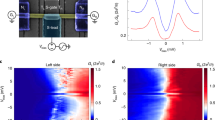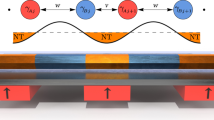Abstract
Hybrid nanowires with proximity-induced superconductivity in the topological regime host Majorana zero modes at their ends. Networks of such structures can produce topologically protected qubits where the fundamental energy scale is given by the inter-pair coupling EM between the zero modes belonging to different wire segments. Here we report on the spectroscopic measurement of EM in an InAs/Al double-island device by tracking the position of the microwave-induced quasiparticle excitations using a radiofrequency charge sensor. At zero magnetic field, photon-assisted tunnelling of Cooper pairs allows us to estimate the Josephson coupling between the islands. In the presence of a magnetic field aligned along the nanowire, we observe the 1e periodic excitation spectrum resulting from a zero-energy subgap state that emerges in a magnetic field. The discrete 1e periodic excitation spectrum is consistent with the coherent hybridization of single-electron states belonging to two opposite-parity branches. The dependence of excitation frequency on detuning indicates a sizable (GHz-scale) and controllable hybridization of zero modes across the junction separating islands, a requirement for applications related to Majorana-based qubits.
This is a preview of subscription content, access via your institution
Access options
Access Nature and 54 other Nature Portfolio journals
Get Nature+, our best-value online-access subscription
$29.99 / 30 days
cancel any time
Subscribe to this journal
Receive 12 print issues and online access
$209.00 per year
only $17.42 per issue
Buy this article
- Purchase on Springer Link
- Instant access to full article PDF
Prices may be subject to local taxes which are calculated during checkout




Similar content being viewed by others
Data availability
The data represented in the main text figures are available as source data with the online version of the paper. All other data that support the plots within this paper and other findings of this study are available from the corresponding author upon reasonable request.
References
Lafarge, P., Joyez, P., Esteve, D., Urbina, C. & Devoret, M. H. Two-electron quantization of the charge on a superconductor. Nature 365, 422–424 (1993).
Nakamura, Y., Pashkin, Y. A. & Tsai, J. S. Coherent control of macroscopic quantum states in a single-Cooper-pair box. Nature 398, 786–788 (1999).
Hützen, R., Zazunov, A., Braunecker, B., Yeyati, A. L. & Egger, R. Majorana single-charge transistor. Phys. Rev. Lett. 109, 166403 (2012).
van Veen, J. et al. Magnetic-field-dependent quasiparticle dynamics of nanowire single-Cooper-pair transistors. Phys. Rev. B 98, 174502 (2018).
Shen, J. et al. Parity transitions in the superconducting ground state of hybrid InSb-Al coulomb islands. Nat. Commun. 9, 4801 (2018).
Albrecht, S. M. et al. Exponential protection of zero modes in Majorana islands. Nature 531, 206–209 (2016).
Aasen, D. et al. Milestones toward Majorana-based quantum computing. Phys. Rev. X 6, 031016 (2016).
Karzig, T. et al. Scalable designs for quasiparticle-poisoning-protected topological quantum computation with Majorana zero modes. Phys. Rev. B 95, 235305 (2017).
Chang, W. et al. Hard gap in epitaxial semiconductor–superconductor nanowires. Nat. Nanotechnol. 10, 232–236 (2015).
Krogstrup, P. et al. Epitaxy of semiconductor–superconductor nanowires. Nat. Mater. 14, 400–406 (2015).
Schoelkopf, R. J. The radio-frequency single-electron transistor (RF-SET): a fast and ultrasensitive electrometer. Science 280, 1238–1242 (1998).
Razmadze, D. et al. Radio-frequency methods for Majorana-based quantum devices: fast charge sensing and phase-diagram mapping. Phys. Rev. Appl. 11, 064011 (2019).
Oreg, Y., Refael, G. & von Oppen, F. Helical liquids and Majorana bound states in quantum wires. Phys. Rev. Lett. 105, 177002 (2010).
Huang, Y. et al. Metamorphosis of Andreev bound states into Majorana bound states in pristine nanowires. Phys. Rev. B 98, 144511 (2018).
Joyez, P., Lafarge, P., Filipe, A., Esteve, D. & Devoret, M. H. Observation of parity-induced suppression of Josephson tunneling in the superconducting single electron transistor. Phys. Rev. Lett. 72, 2458–2461 (1994).
Lutchyn, R. M., Sau, J. D. & Das Sarma, S. Majorana fermions and a topological phase transition in semiconductor–superconductor heterostructures. Phys. Rev. Lett. 105, 077001 (2010).
Lafarge, P., Joyez, P., Esteve, D., Urbina, C. & Devoret, M. H. Measurement of the even–odd free-energy difference of an isolated superconductor. Phys. Rev. Lett. 70, 994–997 (1993).
Ingold, G. L. & Nazarov, Y. V. in Single Charge Tunneling: Coulomb Blockade Phenomena in Nanostructures (eds Grabert, H. & Devoret, M. H.) 21–107 (Plenum, 1992).
Holst, T., Esteve, D., Urbina, C. & Devoret, M. H. Effect of a transmission line resonator on a small capacitance tunnel junction. Phys. Rev. Lett. 73, 3455–3458 (1994).
Pekola, J. P. et al. Environment-assisted tunneling as an origin of the Dynes density of states. Phys. Rev. Lett. 105, 026803 (2010).
Zhang, H. et al. Quantized Majorana conductance. Nature 556, 74–79 (2018).
Deng, M. T. et al. Majorana bound state in a coupled quantum-dot hybrid-nanowire system. Science 354, 1557–1562 (2016).
Vaitiekènas, S., Deng, M.-T., NygÅrd, J., Krogstrup, P. & Marcus, C. M. Effective g factor of subgap states in hybrid nanowires. Phys. Rev. Lett. 121, 037703 (2018).
Mannila, E. T., Maisi, V. F., Nguyen, H. Q., Marcus, C. M. & Pekola, J. P. Detecting parity effect in a superconducting device in the presence of parity switches. Phys. Rev. B 100, 020502 (2019).
Lehnert, K. W. et al. Measurement of the excited-state lifetime of a microelectronic circuit. Phys. Rev. Lett. 90, 027002 (2003).
Duty, T., Gunnarsson, D., Bladh, K. & Delsing, P. Coherent dynamics of a Josephson charge qubit. Phys. Rev. B 69, 140503 (2004).
Lambert, N. J. et al. Microwave irradiation and quasiparticles in a superconducting double dot. Phys. Rev. B 95, 235413 (2017).
Petersson, K. D., Petta, J. R., Lu, H. & Gossard, A. C. Quantum coherence in a one-electron semiconductor charge qubit. Phys. Rev. Lett. 105, 246804 (2010).
Van Woerkom, D. J. et al. Microwave spectroscopy of spinful Andreev bound states in ballistic semiconductor Josephson junctions. Nat. Phys. 13, 876–881 (2017).
Zurich Instruments UHF User Manual (Zurich Instruments, 2018); https://www.zhinst.com/sites/default/files/download-center/ziUHF_UserManual_13.10_r20274.pdf
Stehlik, J. et al. Fast charge sensing of a cavity-coupled double quantum dot using a Josephson parametric amplifier. Phys. Rev. Appl. 4, 014018 (2015).
Acknowledgements
We thank S. Upadhyay for help with fabrication. The research is supported by Microsoft Project Q and the Danish National Research Foundation. J.S. acknowledges financial support from the Werner Siemens Foundation Switzerland. P.K. acknowledges support from the European Research Commission (grant no. 716655). C.M.M. acknowledges support from the Villum Foundation.
Author information
Authors and Affiliations
Contributions
P.K. developed and grew the InAs/Al nanowires. J.S. fabricated the devices. D.S., D.M.T.Z and J.S. performed the measurements with input from K.D.P. and C.M.M. Data were analysed by D.M.T.Z. and J.I.V., with input from D.I.P., D.S. and T.K. The theoretical model to analyse the data was developed by J.I.V., D.I.P. and T.K. The experiment was conceived by C.M.M. All authors contributed to the interpretation of the data. The manuscript was written by D.M.T.Z., D.S. and C.M.M., with contributions from J.S., J.I.V. and D.I.P. and suggestions from all authors.
Corresponding author
Ethics declarations
Competing interests
The authors declare no competing interests.
Additional information
Publisher’s note Springer Nature remains neutral with regard to jurisdictional claims in published maps and institutional affiliations.
Supplementary information
Supplementary Information
Supplementary Figs. 1–10 and Notes.
Source data
Source Data Fig. 1
Source data for Fig. 1.
Source Data Fig. 2
Source data for Fig. 2.
Source Data Fig. 3
Source data for Fig. 3.
Source Data Fig. 4
Source data for Fig. 4.
Rights and permissions
About this article
Cite this article
van Zanten, D.M.T., Sabonis, D., Suter, J. et al. Photon-assisted tunnelling of zero modes in a Majorana wire. Nat. Phys. 16, 663–668 (2020). https://doi.org/10.1038/s41567-020-0858-0
Received:
Accepted:
Published:
Issue Date:
DOI: https://doi.org/10.1038/s41567-020-0858-0
This article is cited by
-
Quantifying quantum coherence of multiple-charge states in tunable Josephson junctions
npj Quantum Information (2024)
-
Microwave-induced conductance replicas in hybrid Josephson junctions without Floquet—Andreev states
Nature Communications (2023)
-
Recent progress on Majorana in semiconductor-superconductor heterostructures—engineering and detection
Science China Physics, Mechanics & Astronomy (2023)
-
Engineered platforms for topological superconductivity and Majorana zero modes
Nature Reviews Materials (2021)
-
Efficient and continuous microwave photoconversion in hybrid cavity-semiconductor nanowire double quantum dot diodes
Nature Communications (2021)



